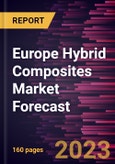Rising Use of Hybrid Composites in Wind Energy and Automotive Industries Fuels Europe Hybrid Composites Market
Rapid developments in material technology continue to support variations in the structure of wind turbines. Many of these variations were primarily introduced to reduce the prices of turbines. Factors such as corrosion resistance, fatigue resistance, toughness, rigidity, weight, and appearance of wind turbines significantly impact their operations. Glass fiber-reinforced plastics (GRPs) are the most used type of composite material in wind turbine manufacturing. The major benefits of using GRPs include hybrid mechanical properties, high corrosion resistance, high-temperature tolerance, simplified manufacturing, and favorable costs.Lightweight materials offer excellent potential for increasing vehicle efficiency as their acceleration requires less energy than heavier ones. According to the Office of Energy Efficiency & Renewable Energy, a 10% decrease in vehicle weight can improve fuel economy by 6-8%. Substituting cast iron and traditional steel components with lightweight materials, such as high-strength steel, aluminum (Al) alloys, magnesium (Mg) alloys, carbon fiber, and polymer composites, can reduce the weight of a vehicle body and chassis by up to 50%, thereby reducing the fuel consumption of a vehicle. The application of hybrid composites in the automotive sector is growing at a significant pace. In this sector, plastics are used in large quantities to produce composites. Hybrid composites have excellent acoustic and thermal properties, which makes them ideal for vehicle interior parts. Furthermore, they are suitable for the manufacturing of non-structural interior components, including seat fillers, seat backs, headliners, interior panels, and dashboards. Therefore, the growing demand for hybrid composites from the automotive industry for the manufacturing of fuel-efficient, lightweight vehicles such as electric vehicles (EVs) is driving the Europe hybrid composites market.
Europe Hybrid Composites Market Overview
The automotive industry is growing significantly across various countries in Europe. According to the report by European Commission, turnover generated by the automotive industry in Europe represents 7% of the region’s total GDP. According to the 2023 report by International Energy Agency, the number of electric vehicles sold in Europe was 2.3 million in 2021 (up from 1.4 million in 2020). Additionally, the presence of prominent automotive players, including Volkswagen AG, Stellantis NV, Mercedes-Benz Group AG, Bayerische Motoren Werke AG, and Renault SA, significantly contributes to the demand for hybrid composites. As per the US Commercial Service report, companies such as Bayerische Motoren Werke AG and Automobili Lamborghini SpA produce cars that constitute composites, making ~6-8% of vehicle weight. Thus, the growing automotive industry in the region is propelling the market growth.Europe Hybrid Composites Market Revenue and Forecast to 2028 (US$ Million)
Europe Hybrid Composites Market Segmentation
The Europe hybrid composites market is segmented into fiber type, resin, application, and country.Based on fiber type, the Europe hybrid composites market is segmented into carbon/aramid, carbon/glass, high-modulus polypropylene (HMPP)/carbon, ultra high molecular weight polyethylene (UHMWPE)/ carbon, and others. The carbon/aramid segment held the largest share of the Europe hybrid composites market in 2023.
Based on resin, the Europe hybrid composites market is segmented into thermoset and thermoplastic. The thermoset segment held a larger share of the Europe hybrid composites market in 2023.
Based on application, the Europe hybrid composites market is segmented into automotive, aerospace, marine, wind energy, sporting goods, and others. The automotive segment held the largest share of the Europe hybrid composites market in 2023.
Based on country, the Europe hybrid composites market is segmented into Germany, France, Italy, the UK, Russia, and the Rest of Europe. Germany dominated in the Europe hybrid composites market in 2023.
Avient Corp, Gurit Holding AG, Hexcel Corp, Lanxess AG, Mitsubishi Chemical Holdings Corp, SGL Carbon SE, Solvay SA, Teijin Ltd, and Toray Industries Inc are some of the leading companies operating in the Europe hybrid composites market.
Reasons to Buy
- Save and reduce time carrying out entry-level research by identifying the growth, size, leading players, and segments in the Europe hybrid composites market.
- Highlights key business priorities in order to assist companies to realign their business strategies.
- The key findings and recommendations highlight crucial progressive industry trends in Europe hybrid composites market, thereby allowing players across the value chain to develop effective long-term strategies.
- Develop/modify business expansion plans by using substantial growth offering developed and emerging markets.
- Scrutinize in-depth Europe market trends and outlook coupled with the factors driving the market, as well as those hindering it.
- Enhance the decision-making process by understanding the strategies that underpin security interest with respect to client products, segmentation, pricing and distribution.
Table of Contents
Companies Mentioned
- Avient Corp
- Gurit Holding AG
- Hexcel Corp
- Lanxess AG
- Mitsubishi Chemical Holdings Corp
- SGL Carbon SE
- Solvay SA
- Teijin Ltd
- Toray Industries Inc
Table Information
| Report Attribute | Details |
|---|---|
| No. of Pages | 160 |
| Published | October 2023 |
| Forecast Period | 2023 - 2028 |
| Estimated Market Value in 2023 | 300.08 Million |
| Forecasted Market Value by 2028 | 540.72 Million |
| Compound Annual Growth Rate | 12.5% |
| Regions Covered | Europe |
| No. of Companies Mentioned | 9 |









